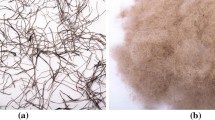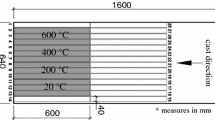Abstract
This study investigates the effect of diameter, length and melting point of fibres on spalling protection of concrete in fire. Three different diameters (0.012, 0.02 and 0.04 mm), three different lengths (9, 12 and 19 mm) and two different types (nylon and polypropylene) of fibres were investigated. Fibre volume (v%) or fibre weight per unit volume of concrete are commonly used parameters for fibre addition, but are dependent parameters on diameter of fibres. This study reports a better parameter for the expression of fibre addition which is independent of diameter, namely, number of fibres per cubic centimeter (N). When 12 mm length polypropylene fibre addition is expressed by v%, the minimum requirement for spalling protection is v = 0.20% for 0.04 mm diameter fibres and v = 0.05% for 0.02 mm diameter fibres. If the fibre addition is expressed in N, the minimum requirement is N = 133/cm3 for both cases regardless of fibre diameter. Hence, the diameter of fibres has limited effect on spalling protection of concrete. If the fibre addition is expressed in v%, the diameter seems to have an effect due to the fact that parameter v% is a function of diameter. In addition, increasing the length of fibres has the effect of reducing the required N for spalling protection. When fibre length is increased from 12 to 19 mm, the minimum requirement is reduced from N = 133 to 42/cm3. The melting point of the fibres also has an influence on spalling protection, which is discussed in detail by comparing nylon and polypropylene fibre results.










Similar content being viewed by others
References
Hertz KD (1992) Danish investigations on silica fume concretes at elevated temperatures. ACI Mater J 89:345–347
Phan LT, Carino NJ (2002) Effects of test conditions and mixture proportions on behavior of high-strength concrete exposed to high temperature. ACI Mater J 99:54–66
Han CG, Han MC, Heo YS (2009) Improvement of residual compressive strength and spalling resistance of high-strength RC columns subjected to fire. Constr Build Mater 23:107–116
Sanjayan G, Stocks LJ (1993) Spalling of high-strength silica fume concrete in fire. ACI Mater J 90:170–173
Consolazio GR, McVay MC, Rish JW III (1998) Measurement and prediction of pore pressures in saturated cement mortar subjected to radiant heating. ACI Mater J 95:525–536
Fu YF, Wong YL, Tang CA, Poon CS (2004) Thermal induced stress and associated cracking in cement-based composite at elevated temperature. Part II: thermal cracking around multiple inclusions. Cem Concr Compos 26:113–126
Heo YS, Sanjayan JG, Han CG, Han MC (2011) Construction application of fibre/mesh method for protecting concrete columns in fire. Constr Build Mater 25:2928–2938
Bilodeau A, Kodur VKR, Hoff GC (2004) Optimization of the type and amount of polypropylene fibres for preventing the spalling of lightweight concrete subjected to hydrocarbon fire. Cem Concr Res 26:163–174
Suhaendi SL, Horiguchi T (2006) Effect of short fibres on residual permeability and mechanical properties of hybrid fibre reinforced high strength concrete after heat exposition. Cem Concr Res 36:1672–1678
Jansson R, Boström L (2008) Spalling of concrete exposed to fire. Fire technology SP report, SP Technical Research Institute of Sweden
Khoury GA (2008) Polypropylene fibres in heated concrete. Part 2: pressure relief mechanisms and modelling criteria. Mag Concr Res 60:189–204
Heo YS, Sanjayan JG, Han CG, Han MC (2011) Critical parameters of nylon and other fibres for spalling protection of high strength concrete in fire. Mater Struct 44:599–610
Heo YS, Sanjayan JG, Han CG, Han MC (2010) Synergistic effect of combined fibers for spalling protection of concrete in fire. Cem Concr Res 40:1547–1554
Heo YS (2006) Influential factors on fire resistance performance of ultra high strength concrete and mechanism models of spalling phenomenon. Master thesis, Cheongju University, Korea
Knack I (2009) New PP-fibre with exceptional melting characteristics for improved fibre protection in concrete building. In: 1st international workshop on concrete spalling due to fire exposure, Leipzig, Germany, pp 211–220
Phan LT (2007) Spalling and mechanical properties of high strength concrete at high temperature. In: Proceedings concrete under severe conditions, France, pp 1595–1608
Balaguru PN, Shah SP (1992) Fiber-reinforced cement composites. McGraw-Hill Inc., New York
Papworth F (2000) Affect of synthetic fibres and silica fume on explosive spalling of high performance concrete exposed to fire. South East Asia Construction, Trade Link Media, Singapore, pp 1–6
Bentz DP (2000) Fibers percolation, and spalling of high-performance concrete. ACI Mater J 97:351–359
Acknowledgments
The work presented in this paper was funded by Monash Graduate Scholarship (MGS) from Monash University, and Australian Research Council Grant DP 0664309.
Author information
Authors and Affiliations
Corresponding author
Rights and permissions
About this article
Cite this article
Heo, YS., Sanjayan, J.G., Han, CG. et al. Limited effect of diameter of fibres on spalling protection of concrete in fire. Mater Struct 45, 325–335 (2012). https://doi.org/10.1617/s11527-011-9768-z
Received:
Accepted:
Published:
Issue Date:
DOI: https://doi.org/10.1617/s11527-011-9768-z




